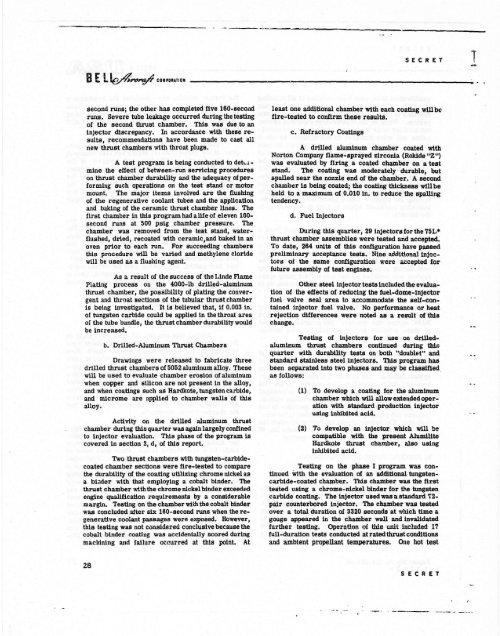System 112A - The Black Vault
System 112A - The Black Vault
System 112A - The Black Vault
Create successful ePaper yourself
Turn your PDF publications into a flip-book with our unique Google optimized e-Paper software.
B E lle.#~ CmOUTlOI<br />
SECRET<br />
--------------------------------------------------~..<br />
1<br />
second runs; the other has completed five 160-second<br />
runs. Severe tube leakage occurred du.l'ing the testing<br />
of the second thrust chamber. This was due to an<br />
injector discrepancy. In accordance with these results,<br />
recommendations have been made to cut all<br />
new thrust chambers with throat plugs.<br />
A test program is being conducted to det\-l <br />
mine the effect of between-run servicing procedures<br />
on thrust chamber durability and the adequacy of performing<br />
such operations on the test stand or motor<br />
mount. <strong>The</strong> major items involved are the nushing<br />
of the regenerative coolant tubes and the application<br />
and baking of the ceramic thrust chamber linell. <strong>The</strong><br />
first chamber in this program had a life of eleven 160<br />
second runs at 500 psig chamber pressure. <strong>The</strong><br />
chamber was removed from the test stand, waterflushed,<br />
dried, recoated with ceramlc,and baked in an<br />
oven prior to each run. For succeeding chambers<br />
this procedure will be varied and methylene cloride<br />
will be used as a flushing ageilt.<br />
As a result of the success of the Linde Flame<br />
Plating process on the 4000-lb drilled-aluminum<br />
thrust chamber, the pos81b1l1ty of plating the COnvergent<br />
and throat sections of the tubular thrust chamber<br />
is being investigated. It is believed that, if 0.003 in.<br />
of tungsten carbide could be applied in the throat area<br />
of the tube bundle, the thrust chamber durabUitywould<br />
be increased.<br />
b. Drilled-Aluminum Thrust Chambers<br />
Drawings were released to fabricate three<br />
drilled thrust chambers of 5052 aluminum alloy. <strong>The</strong>se<br />
will be used to evaluate chamber erosion of aluminum<br />
when copper and silicon are not present in the alloy,<br />
and when coatings such as Hardkote, tungstenca.rbide,<br />
and microme are appUed to chamber walls of this<br />
alloy.<br />
Activity on the drilled aluminum thrust<br />
chamber during this quarter was again largely confined<br />
to injector evaluation. This phase of the program is<br />
covered in section 2, d, of this report.<br />
Two thrust chambers with tungsten-carbidecoated<br />
chamber sections were fire-tested to compare<br />
the durab1l1ty of the coating utilizing chrome r.1ckel as<br />
a bi;tder with that employing a cobalt binder. <strong>The</strong><br />
thrust chamber with the chrome nickel binder exceeded<br />
engine qualification .. equirements by a considerable<br />
mugln. Testing on the chamber withthe cobalt binder<br />
was concluded after six 160-second runs when the regenerative<br />
coolant pasBages were exposed. However,<br />
this testing was not considered conclusive because the<br />
cobalt binder coating was accidentally scored during<br />
machining and failure occurred at this point. At<br />
least one additional chamber With each coating Will be<br />
fire-tested to confirm these results.<br />
c. Refractory Coatings<br />
A drilled aluminum chamber coated with<br />
Norton Company flame-sprayed zirCOnia (Rokide "Z")<br />
was evaluated by firing a coated chamber on a test<br />
stand. <strong>The</strong> coating was .moderately durable, but<br />
spilled neu the nozzle end of the chamber. A second<br />
chamber Is being coated; the coating thickness will be<br />
held to a maximum of 0.010 In. to reduce the spall1ng<br />
tendency.<br />
d. Fuel Injectors<br />
During this quarter, 29 injectorsfor the 75L*<br />
thrust chamber assemblies were tested and accepted.<br />
To date, 264 units of this configuration have passed<br />
preliminary acceptance tests. Nine lI,d.dit:t.onal1nj~ctOI'l'<br />
of the same configuration were ACcepted for<br />
future assembly of test engines.<br />
Other steel injector testsincluded the evaluation<br />
of the effects of redueing the fuel-dome-injeetor<br />
fuel valve seal area to accommodate the self-contained<br />
injector fuel valve. No performance or heat<br />
rejection differences were noted as a result of this<br />
change.<br />
Testing of injectors for use on drilledaluminum<br />
thrust chambers continued during thilf.<br />
quarter with durabllity tests on both "doublf!t" and<br />
standard stainless steel injectors. This program has<br />
been separated into two phases and may be classified<br />
as follows: .<br />
(1) To develop a coating for the aluminum<br />
chamber which wlll allow extended operation<br />
with standard production injector<br />
using inhibited acid.<br />
(2) To develop an injector which will be<br />
compatible with the present Aiumillte<br />
Hardkote thrust chamber, also using<br />
inhibited acid.<br />
Testing on the phase I program was continued<br />
With the evaluation of an additional tungstencarbide-coated<br />
chamber. T'nis chamber was the first<br />
tested using a chrome-nickel binder for the tungsten<br />
ca.rbide coating. <strong>The</strong> injector used was a standard 72<br />
pair caunterbored injector. '<strong>The</strong> chamber was tested<br />
over a total duration of 3320 seconds at which time a<br />
gouge appeared in the chamber Wlfll and invalidated<br />
further testing. Operation af thilll unit included 17<br />
full-duration tests conducted at rated thrustconditions<br />
and ambient propellant temperatures. One hot test<br />
28<br />
SECRET<br />
.~ . . _---
















